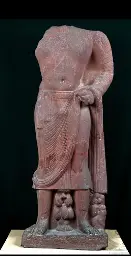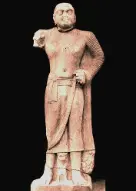Introduction
The Kushan empire likely constituted one of the five segments of the Yuezhi confederation, comprising ancient nomadic people from Central Asia. Ruling until 350 CE, the Kushan dynasty's most influential leader was Kanishka (127-150 CE). Renowned not only as a formidable conqueror but also as a supporter of religion and the arts, he initiated the Saka era in 78 A.D. During Kanishka's reign, the Kushan realm was bifurcated between Purushapura and Mathura. This article delves into the era of Kanishka (127 CE-150 CE), offering insights beneficial for UPSC exam preparation.4

The Kanishka - Features
- Kanishka I, also known as Kanishka the Great, was a formidable emperor of the Kushan dynasty.
- His reign marked the pinnacle of the Kushan Empire, showcasing achievements in military, political, and spiritual domains.
- Descendant of Kujula Kadphises, the founder of the Kushan empire.
- The empire under Kanishka's rule extended from Central Asia and Gandhara to Pataliputra on the Gangetic plain.
- Main capital: Gandhara, specifically at Purushapura (Peshawar); another major capital at Mathura.
- Kanishka's coins were discovered in Tripuri (present-day Jabalpur).
- Conquests and patronage of Buddhism played a crucial role in the development of the Silk Road.
- Mahayana Buddhism transmission from Gandhara to China across the Karakoram range.
- Around 127 CE, he replaced Greek with Bactrian as the empire's official language of administration.
- Previous belief: Kanishka ascended to the throne in 78 CE, marking the start of the Saka calendar era.
- Contemporary perspective: Historians, including Falk, now place Kanishka's ascent in 127 CE.
Kanishka’s Conquests
- At the time of Kanishka's accession, his empire encompassed Afghanistan, Gandhara, Sind, and Punjab.
- He expanded his dominion by conquering Magadha, reaching as far as Pataliputra and Bodh Gaya.
- As per Kalhana, Kanishka invaded and occupied Kashmir, and his coins were found in various locations like Mathura, Sravasti, Kausambi, and Benares, suggesting control over the Gangetic plain.
- Engaging in conflicts with the Chinese, Kanishka initially faced defeat against General Pancho but succeeded in a subsequent expedition, defeating Pancho's son, Panyang.
- Kanishka incorporated territories such as Kashgar, Yarkand, and Khotan into his expanding empire.
- The geographical expanse of Kanishka's realm ranged from Gandhara in the west to Benares in the east and from Kashmir in the north to Malwa in the south.
- His primary capital was Purushapura (modern-day Peshawar), with Mathura serving as another significant city in his empire.
Conquests in South and Central Asia
- Kanishka's expansive empire covered a vast territory, extending from southern Uzbekistan and Tajikistan in the northwestern reaches, across the Amu Darya (Oxus), and reaching as far as Northern India, encompassing Mathura in the southeast. The Rabatak inscription even suggests his control over Pataliputra and Sri Champa.
- Within his dominion, Kashmir held significance, featuring a town named Kanishkapura (modern-day Kanispora) near the Baramulla Pass, boasting the remains of a substantial stupa.
- Despite the extent of his rule in Central Asia, details remain unclear. According to Hou Hanshu, the Book of the Later Han, General Ban Chao engaged in battles near Khotan against a Kushan army of 70,000 led by the little-known Kushan viceroy Xie. Ban Chao claimed victory, compelling the Kushans to retreat with a scorched-earth strategy.
- In the Tarim Basin, Kashgar, Khotan, and Yarkand served as Chinese dependencies in modern-day Xinjiang. Notably, Kanishka coins have been unearthed in the Tarim Basin.
- A pivotal aspect of Kanishka's imperial agenda was the control of both land (Silk Road) and sea trade routes connecting South Asia to Rome.
Kanishka’s Coins
- Kanishka's coins showcase a remarkable blend of religious syncretism, featuring images of Indian, Greek, Iranian, and Sumero-Elamite deities.
- Initially, the coins from the early phase of his reign bear Greek legends and portray Greek divinities.
- Subsequent coins display legends in Bactrian, the Iranian language spoken by the Kushans, with Greek deities replaced by their Iranian counterparts.
- The king is commonly depicted on these coins as a bearded figure donning a long coat and ankle-gathered trousers, with flames emanating from his shoulders.
- His attire includes large rounded boots, and he is depicted wielding a long sword and lance, often shown making a sacrifice on a small altar.
- A life-size limestone relief of Kanishka, attired similarly with a stiff embroidered surplice beneath his coat, spurs attached to his boots, and light gathered folds of trousers, was housed in the Kabul Museum until its destruction by the Taliban.

Kanishka and Buddhism
- Kanishka holds a pivotal place in Buddhist tradition, not only for his personal belief in Buddhism but also for actively promoting its teachings.
- A significant testament to his commitment to Buddhism is his role as the head of the 4th Buddhist Council in Kashmir, where Vasumitra and Ashwaghosha also played key roles.
- During his lifetime, he played a crucial role in the creation of images of the Buddha, meticulously based on the 32 physical signs associated with the enlightened one.
- Kanishka demonstrated support for the Gandhara School of Greco-Buddhist Art and the Mathura School of Art, showcasing his patronage for the artistic expression of Buddhist ideals.
- While Kanishka seems to have embraced both Buddhist and Persian traits, his inclination towards Buddhism is evident through his profound devotion to Buddhist teachings and prayer styles, documented in various works related to the Kushan empire.
- Kanishka's legacy is further illuminated by the Buddhist statues associated with him, reflecting his enduring impact on the representation of Buddhist art and philosophy.
Kanishka's Buddhist statues
Various Buddhist statues, including numerous Bodhisattva statues originating from the Art of Mathura, can be directly attributed to Kanishka's reign. Additionally, certain statues from Gandhara bear inscriptions indicating a date in an era currently identified as the Yavana era, spanning from 186 to 175 BCE.
 Kosambi Bodhisattva
Kosambi Bodhisattva
 Sarnath's Bala Bodhisattva
Sarnath's Bala Bodhisattva
Conclusion
Kanishka organized the fourth Buddhist Council at Kundalvana in Kashmir. Despite his religious tolerance, he actively supported Buddhism, as evident from the deities featured on his coins representing India, Greece, and Zoroastrianism. A notable patron of art and architecture, he played a pivotal role in the flourishing of the Gandhara School of Art. Additionally, Kanishka was a key advocate for the Mahayana school of Buddhism, contributing significantly to its dissemination in China. The circumstances of his death remain unclear.

